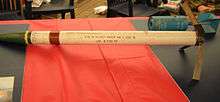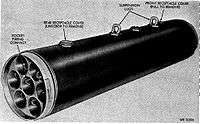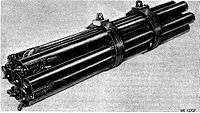Folding-Fin Aerial Rocket

The Mk 4 Folding-Fin Aerial Rocket (FFAR), also known as Mighty Mouse, was an unguided rocket used by United States military aircraft. 2.75 inches (70 mm) in diameter, it was designed as an air-to-air weapon for interceptor aircraft to shoot down enemy bombers, but primarily saw service as an air-to-surface weapon.
History
The advent of jet engines for fighters and bombers posed new problems for interceptors. With closing speeds of 1,500 ft/s (457 m/s) or more for a head-on interception, the time available for a fighter pilot to successfully target an enemy aircraft and inflict sufficient damage to bring it down was vanishingly small. Wartime experience had shown that .50 caliber (12.7 mm) machine guns were not powerful enough to reliably down a bomber, certainly not in a single volley, and heavy autocannon did not have the range or rate of fire to ensure a hit. Unguided rockets had been proven effective in ground-attack work during the war, and the Luftwaffe had shown that volleys of their Werfer-Granate 21 rockets, first used by elements of the Luftwaffe's JG 1 and JG 11 fighter wings on July 29, 1943 against USAAF bombers attacking Kiel and Warnemünde, could be a potent air-to-air weapon as well . The summer and autumn of 1944 saw the adoption of the folding-fin R4M unguided rocket for use underneath the wings of the Messerschmitt Me 262 jet fighter for bomber destroyer duties against the USAAF's Eighth Air Force heavy bombers.
The FFAR was developed in the late 1940s by the US Navy Naval Ordnance Test Center and North American Aviation. Mass production was established at the facilities of the Norris-Thermador Corp., Los Angeles, and the Hunter Douglas Division of the Bridgeport Brass Co., Riverside, California[1] Fuzes were manufactured by the Bulova Watch Co., Jackson Heights, Queens, N.Y.,[2] with rocket propellant supplied by Hercules Inc., Wilmington, Delaware,[3] metal parts supplied by Aerojet General, Downey, California,[4] and miscellaneous spare parts were made by North American Aviation.[5]
The original Mk 4 FFAR was about 4 ft (1.2 m) long and weighed 18.5 lb (8.4 kg), with a high-explosive warhead of about 6 lb (2.7 kg). Like the Third Reich Luftwaffe's R4M projectile of World War II, it had folding fins that flipped out on launch to spin-stabilize the rocket, with the FFAR using half the number (four) of fins in comparison to the R4M's set of eight folding fins. Its maximum effective range was about 3,700 yards (3,400 m). Because of its low intrinsic accuracy, it was generally fired in large volleys, some aircraft carrying as many as 104 rockets.
FFARs were the primary armament of many NATO interceptor aircraft in the early 1950s, including the F-86D, F-89, F-94C, and the CF-100. They were also carried by the F-102 Delta Dagger to supplement its guided missile armament.

The Mk 4 was dubbed "Mighty Mouse" in service, after the popular cartoon character.
The Mighty Mouse was to prove a poor aerial weapon. Although it was powerful enough to destroy a bomber with a single hit, its accuracy was abysmal. Its spin rate was not high enough to compensate for the effects of wind and gravity drop, and the rockets dispersed widely on launch: a volley of 24 rockets would cover an area the size of a football field.
As a result, by the late 1950s it had been largely abandoned as an aircraft weapon in favor of the guided air-to-air missiles then becoming available. The Mk 4 found other uses, however, as an air-to-ground weapon, particularly for the new breed of armed helicopter. A volley of FFARs was as devastating as a heavy cannon with far less weight and recoil, and in the ground-attack role its marginal long-range accuracy was less important. It was fitted with a more powerful motor to become the Mk 40. The Mk 40 was a universal motor developed from the Mk 4 2.75 FFAR, and could be fitted with different warheads depending on the mission. Pods (typically carrying seven or 19 rockets) were created for various applications, and a wide variety of specialized warheads were developed for anti-personnel, anti-tank, and target-marking use.
The FFAR has been developed into the modern Hydra 70 series, which is still in service.
US Mk 40 FFAR Launchers
The United States was the primary user of this type of weapon and developed a number of different launching pods for it. Initially pods were intended to be disposed of by launching aircraft, either in flight or on the ground following a mission. With the advent of the armed helicopter, the need for launching pods that were reusable became apparent. Though the rocket was initially developed by the US Navy, the US Air Force and later US Army were most responsible for the development of rocket pods for all services. These pods are described as follows:
- Launchers designated under the US Air Force system:
| Designation | Description |
|---|---|
| LAU-3/A | 19-Tube 70 mm (2.75”) rocket launcher |
| LAU-3A/A | LAU-3/A variant; differences unknown |
| LAU-3B/A | LAU-3A/A variant; differences unknown; US Army XM159 |
| LAU-3C/A | LAU-3B/A variant; supports single or ripple fire |
| LAU-3D/A | LAU-3C/A variant; differences unknown |
| LAU-32/A | 7-Tube 70 mm (2.75”) rocket launcher |
| LAU-32A/A | LAU-32/A variant; differences unknown; US Army XM157A |
| LAU-32B/A | LAU-32A/A variant; differences unknown |
| LAU-49/A | 7-Tube 70 mm (2.75”) rocket launcher |
| LAU-51/A | 19-Tube 70 mm (2.75”) rocket launcher |
| LAU-59/A | 7-Tube 70 mm (2.75”) rocket launcher |
| LAU-60/A | 19-Tube 70 mm (2.75”) rocket launcher; similar to LAU-3/A series except in the position of the grounding safety device |
| LAU-61/A | 19-Tube 70 mm (2.75”) rocket launcher; US Army M159A1 |
| LAU-61A/A | LAU-61/A variant; differences unknown |
| LAU-61B/A | LAU-61A/A variant; differences unknown |
| LAU-68/A | 7-Tube 70 mm (2.75”) rocket launcher; US Army M158A1 |
| LAU-68A/A | LAU-68/A variant; differences unknown |
| LAU-68B/A | LAU-68A/A variant; differences unknown |
| LAU-68C/A | LAU-68/A variant; differences unknown |
| LAU-69/A | 19-Tube 70 mm (2.75”) rocket launcher; US Army M200A1 |
- Launchers designated under the US Army system:


| Designation | Description |
|---|---|
| XM141 | Launcher, 2.75-inch Rocket, Seven-Tube, Reloadable, Reusable; 7-Tube 70 mm (2.75”) rocket launcher |
| XM157A | 7-Tube 70 mm (2.75”) rocket launcher; not compatible w/ Mk 66 rocket motor; USAF LAU-32A/A |
| XM157B | XM157A variant; longer launch tubes, capable of further mounting an XM118 dispenser |
| XM158/M158 | Launcher, 2.75-inch Rocket, Seven-Tube, Reloadable, Reusable, Repairable; 7-Tube 70 mm (2.75”) rocket launcher |
| M158A1 | M158 variant; modified hardback mount; USAF LAU-68/A |
| XM159 | Launcher, 2.75-inch FFAR, 19-Tube, Reloadable, Reusable, Not Repairable; 19-Tube 70 mm (2.75”) rocket launcher; USAF LAU-3B/A |
| XM159B/C | XM159 variants; differences unknown |
| M159 | 19-Tube 70 mm (2.75”) rocket launcher; type standardization of what XM159 unknown |
| M159A1 | M159 variant; differences unknown; USAF LAU-61/A |
| XM200/M200 | 19-Tube 70 mm (2.75”) rocket launcher |
| M200A1 | M200 variant; differences unknown; USAF LAU-69/A |
| MA-2A | 2-Tube rocket launcher |
Early UH-1B/UH-1C Gunships had the XM-3 Subsystem using paired 24 round rectangular launchers mounted near the back edge of the sliding side doors. These pods were ground reloadable and were semi-permanent aircraft parts. The mounting point had been used to mount booms for 3 SS-11 Launchers on each side for anti-tank missions. The co-pilot had a roof mounted sight and control box to fire these. Later UH-1C and D aircraft had a mount on each side to carry a 7 round pod coupled with paired M-60D machine guns. Some carried M-134 Miniguns with 3000 rounds per gun instead, though these aircraft were normally used by Air Cavalry units, not the Aerial Rocket Artillery (ARA) units.
Also various ground launchers using discarded aircraft pods were used for fire base defence. A towed configuration consisting of six 19-round pods called a Slammer was tested for airborne infantry support. The range was approximately 7000 meters using Hydra 70 family rockets.
Warheads for the Mk 40 Motor
With the development of the Mk 40 Mod 0 universal motor came the development of a considerable number of different warheads, as well as, a number of different fuzing options. A list of those warheads believed to be developed before the replacement of the Mk 40 motor with the Mk 66 motor is as follows:
Fuzing Options
| # | Designation | Description |
|---|---|---|
| 1 | M423 | Point Detonating |
| 2 | XM438/M438 | Point Detonating |
| 3 | Mk 352 Mod 0/1/2 | Point Detonating |
| 4 | M429 | Proximity Airburst |
| 5 | M442 | Airburst, Motor-Burnout Delay |
| 6 | Model 113A | Airburst, Motor-Burnout Delay |
US military Warheads
| Designation | Description | Fuzing Options |
|---|---|---|
| XM80 | Submunition warhead w/ 32 XM100 CS canisters | Unknown, believed to have an integral fuze |
| XM99 | Submunition warhead w/ 32 XM100 CS canisters; simplified XM80 | Unknown, believed to have an integral fuze |
| M151 | High Explosive (HE) | 1,3,4,5 |
| M152 | High Explosive (HE) w/ red smoke marker | 1,3,4,5 |
| M153 | High Explosive (HE) w/ yellow smoke marker | 1,3,4,5 |
| M156 | White Phosphorus (WP) | 1,3,4,5 |
| XM157 | Red smoke; unknown compound | 1,3,4,5 |
| XM158 | Yellow smoke; unknown compound | 1,3,4,5 |
| M247 | High-Explosive Anti-Tank (HEAT)/High-Explosive Dual Purpose (HEDP) | 2 (Integral to Warhead) |
| M257 | Parachute Illumination | 5 (Integral to Warhead) |
| Mk 67 Mod 0 | White Phosphorus (WP) | 1,3,4,5 |
| Mk 67 Mod 1 | Red Phosphorus (RP) | 1,3,4,5 |
| WDU-4/A | APERS warhead w/ unknown number of flechettes of unknown weight | 11 (Integral to Warhead) |
See also
- List of rockets
- SNEB
- Hydra 70
- FZ68 & FZ67 air-to-ground FFAR rocket motor 70mm/2.75"
- CRV-7
- Aerial Rocket Artillery
- List of U.S. Army Rocket Launchers By Model Number
- LOCAT - used three FFAR rockets
- Battle of Palmdale
References
- ↑ Missiles 1958 // Flight and Aircraft Engineer, 5 December 1958, v. 74, no. 2602, p. 898.
- ↑ Defense Procurement. // Defense Industry Bulletin, May 1966, p. 25.
- ↑ Defense Procurement // Defense Industry Bulletin, November 1966, p. 43.
- ↑ Defense Procurement. // Defense Industry Bulletin, August 1967, p. 32.
- ↑ Contracts. // Missiles and Rockets, May 18, 1959, v. 5, no. 20, p. 60.
External links
| Wikimedia Commons has media related to Folding Fin Aerial Rockets. |
- Fighter Fires Rocket Missiles Like Machine Gun Bullets 1951 article about recently introduced 2.75 inch Mighty Mouse rocket
